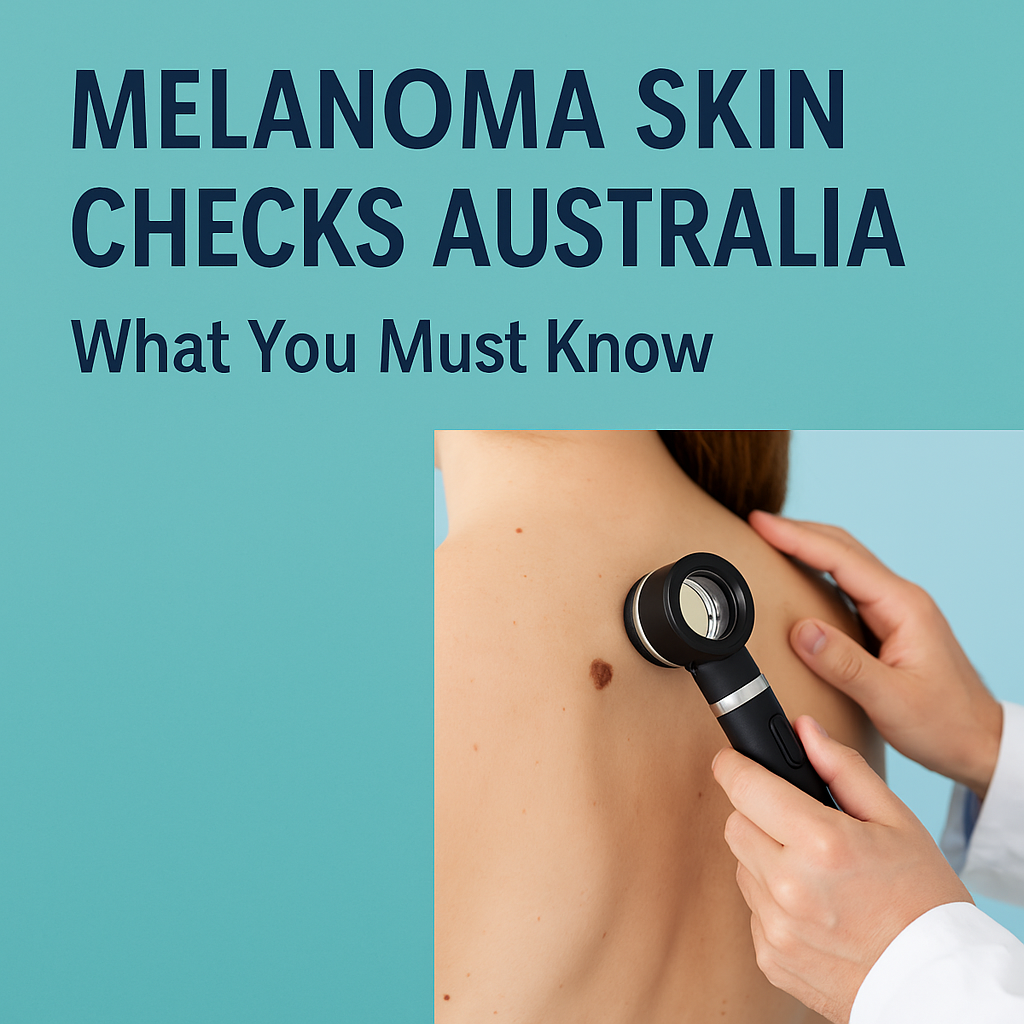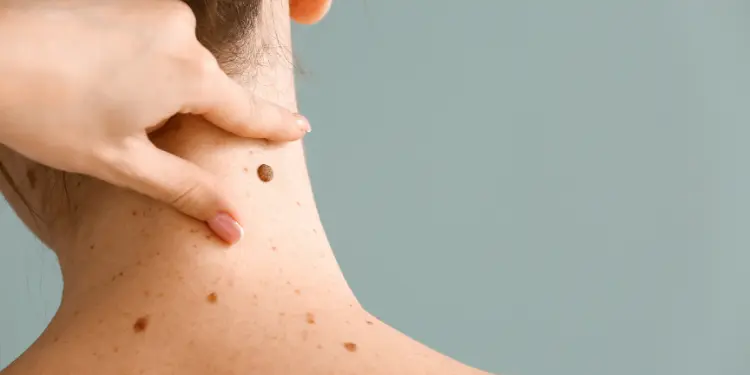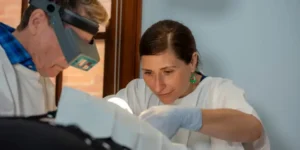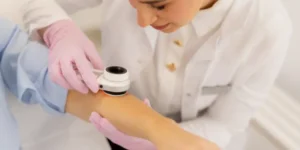Have you been putting off a melanoma skin check, even though you know it’s important? Melanoma Skin Checks Australia are vital, Australia has the highest skin cancer rate globally, with two in three Aussies diagnosed by age 70.
A fast, painless skin check could detect melanoma early, when treatment is simpler and outcomes are far better. Don’t wait your skin could be telling you something.
What is Melanoma?

Melanoma is the most deadly form of skin cancer. It starts in cells called melanocytes that make the skin pigment giving skin its color. These cells can grow out of control and form tumors that can spread to other body parts if not caught early.
Melanoma often looks like a changing mole or a new spot on your skin. It might be black or brown, but can also appear red, pink, blue, or white. Unlike other skin cancers, melanoma can grow fast and move to other parts of your body through your blood or lymph system.
Melanoma is aggressive, so regular skin checks are essential.
The risk of getting melanoma is much higher in Australia than most other countries. This is due to our sunny climate and high UV levels. People with fair skin, a history of bad sunburns, or family members who’ve had skin cancer face greater risks.
The good news is that finding melanoma early makes it much easier to treat. That’s why skin checks are so vital for all Aussies. We can now examine why these checks are so important for people living in Australia.
Why Regular Skin Checks are Crucial for Australians

Now that we know what melanoma is, let’s discuss why Australians must check their skin often. Australia has some of the highest skin cancer rates in the world. Our sunny climate puts us at risk from too much UV radiation.
Skin checks can find cancer early, before it spreads to other parts of the body. Early spots are much easier to treat. Most skin cancers can be cured if found soon enough.
Regular checks save lives – it’s that simple. You might not notice small changes in moles or new spots without looking for them. Skin cancer can grow without causing pain or other signs at first.
Professional skin checks can spot things you might miss on your own. The Cancer Council reports that early detection through regular checks makes treatment much more likely to work.
This is why all Australians should make skin checks part of their health routine, just like going to the dentist or getting eye tests.
Risk Factors for Melanoma
Australia has the highest rate of skin cancer in the world. Many factors can raise your risk of getting melanoma, the most deadly form of skin cancer.
- Sun exposure is the top risk factor for Australians. Too much UV radiation from the sun damages skin cells and can lead to cancer over time.
- Fair skin burns more easily in the sun. People with pale skin, light hair, or freckles face higher risks than those with darker skin tones.
- A history of sunburns, especially bad ones during childhood, greatly increases your melanoma risk. Even one severe burn can double your chances.
- Your family history matters. If your parents or siblings had melanoma, you have a higher chance of getting it too.
- Moles on your body need watching. People with many moles or unusual-looking moles face a greater risk of skin cancer.
- Age plays a role in melanoma risk. Most cases occur in people over 50, though young people can get it too.
- A past melanoma means you must stay alert. Once you’ve had skin cancer, you have a higher chance of getting another one.
- Weakened immune systems from illness or medications can make it harder for your body to fight off cancer cells.
- Certain jobs put you at risk. Outdoor workers like farmers, builders, and lifeguards face more sun damage over their careers.
- Living in northern parts of Australia means stronger UV rays and higher skin cancer rates than southern states.
- Tanning beds cause the same damage as the sun. Using these machines even once increases your melanoma risk by 20%.
- Men over 50 show the highest rates of deadly melanoma in Australia. They often miss early signs on their backs or scalp.
Early Signs of Melanoma
Spotting melanoma early can save your life. The five-year survival rate increases to over 90% when skin cancer is found before it spreads.
- Changing moles – Any mole that grows, changes shape, or looks different needs a check. Take photos of spots you’re concerned about to track changes over time.
- New spots – Most melanomas are new spots rather than changes to old moles. Monitor any fresh spots that appear, especially after age 30.
- Odd-looking moles – Look for moles that stand out or look different from others on your body. Doctors refer to this as the “ugly duckling sign.”
- Bleeding or oozing – Spots that bleed without injury, ooze fluid, or don’t heal within a few weeks need prompt attention from a GP.
- Itchy or painful spots – Melanoma can sometimes feel itchy, tender, or painful when touched. This isn’t normal for regular moles.
- Dark spots under nails – Dark streaks under fingernails or toenails might be melanoma, not just bruises. These occur more frequently in people with dark skin.
- Spots on less-seen areas – Check places you don’t often see like your scalp, between toes, soles of the feet, and your back. Ask someone to help.
- Color changes – Watch for moles with multiple colors or that change from brown to black, red, white, or blue. This is a key warning sign.
The ABCDE Melanoma Detection Guide
The ABCDE guide helps Aussies spot skin cancer early. This simple tool can save lives by showing you what to look for during skin checks.
- A is for Asymmetry: Normal moles are round and even. Cancer spots often have one half that looks different from the other half. Check if your spot has an odd shape that doesn’t match on both sides.
- B is for Border: Safe moles have smooth, clear edges. Melanoma spots often show ragged, notched, or blurry borders. Look closely at the edges of any new spots on your skin.
- C is for Color: Healthy moles are one color (usually brown). Danger signs include many colors in one spot – black, brown, tan, red, white, or blue patches. Watch for spots with mixed or changing colors.
- D is for Diameter: Most normal moles stay smaller than 6mm (about the size of a pencil eraser). Larger spots need a doctor’s check. Size matters, but even small spots can be cancer if they show other warning signs.
- E is for Evolving: Any mole that changes needs quick attention. This includes growth, shrinking, color shifts, new symptoms like itching, or bleeding. Take photos of spots so you can track changes over time.
- Ugly Duckling Sign: This extra tip helps find odd spots. Most moles on your body look alike. The “ugly duckling” is the one spot that stands out from all others. Pay extra care to any spot that looks different from the rest.
- Sun-Exposed Areas: Check places that get lots of sun first – face, ears, neck, arms, and scalp check. Melanoma loves sun damage, so these spots face higher risk.
- Hidden Spots: Don’t skip checking between toes, soles of feet, under nails, and other spots that rarely see the sun. Melanoma can grow anywhere on your skin.
Types of Skin Cancer to Watch For
Australia has three main types of skin cancer you need to know about. Basal cell carcinoma (BCC) is the most common. It grows slowly and looks like a pink, pearly bump or a flat, scaly patch.
Squamous cell carcinoma (SCC) shows up as red, scaly patches or open sores that don’t heal. Both BCC and SCC rarely spread to other body parts but still need quick care. Melanoma is the most deadly kind.
It often starts in moles and can look like dark spots with odd shapes or colors. Melanoma can spread fast to other organs if not caught early.
Early detection of skin cancer saves lives – know what to look for and check your skin often.
Other less common skin cancers include Merkel cell carcinoma and cutaneous T-cell lymphoma. Some pre-cancerous spots called solar keratosis can turn into cancer if not treated. These rough, scaly patches form on sun-damaged skin.
People with fair skin, lots of moles, or a family history of skin cancer face higher risks. The good news? Most skin cancers can be fixed if found early through regular skin checks.
Self-Examination for Skin Cancer
Now that you know the types of skin cancer to watch for, you need to check your own skin often. Regular self-checks help you spot changes early when treatment works best.
- Look at your whole body in a full-length mirror in a well-lit room. Check front, back, and both sides with your arms raised.
- Pay extra care to sun-exposed areas like your face, neck, ears, and scalp check. Use a hand mirror or ask someone to help check spots you can’t see well.
- Check hidden spots such as between toes, under nails, on soles of feet, and in the genital area. Skin cancer can grow in places that never see the sun.
- Take photos of odd spots or moles to track changes over time. Many skin cancers grow or change shape slowly.
- Learn the ABCDE rule to spot melanoma signs: Asymmetry, Border issues, Color changes, Diameter growth, and Evolution of the spot.
- Set a monthly reminder on your phone for skin checks. Pick an easy date to remember, like the first day of each month.
- Create a skin map by drawing dots on a body chart to mark where your moles are. This makes it easier to notice new spots.
- Check for new spots that look different from your other moles – this is called the “ugly duckling” sign and needs quick doctor review.
- Feel your skin for hard lumps, as nodular melanoma can form bumps that grow fast. These might not follow the normal ABCDE rules.
- See your GP right away if you find spots that itch, bleed, or don’t heal within a month. These are key warning signs that need expert eyes.
Professional Skin Checks
Professional skin checks by doctors offer a more detailed look at your skin than you can do at home. These checks use special tools to spot skin cancer early, when it’s most treatable.
Who to Consult for a Skin Check
For the best skin checks, talk to doctors who specialize in skin cancer detection. Your family doctor (GP) can do basic skin checks during your regular visits. They can spot unusual skin changes and refer you to skin experts if needed.
Skin Cancer Hub doctors have special training in detecting and treating skin cancer. They use advanced tools to check your whole body.
Early skin cancer checks save lives – prompt detection is essential.
You don’t need a referral from another doctor to see a skin cancer doctor. Many skin clinics offer comprehensive care in one location – from initial examination to tests and treatment.
This reduces time and anxiety. If you have fair skin, numerous moles, or previous skin cancer, you might need more frequent skin doctor appointments. Most skin cancer can be successfully treated if detected early.
Benefits of Professional Skin Checks
Professional skin checks can save your life. Trained doctors spot skin cancer signs that you might miss during home checks.
Benefits of Professional Skin Checks:
- Expert eyes catch tiny changes. Skin cancer doctors have examined thousands of moles and spots, so they identify what looks wrong even when it’s very small.
- Full body checks cover hard-to-see spots. Doctors check areas you can’t view well yourself, like your back, scalp check, and between toes.
- Special tools see below the skin surface. Doctors use tools like dermoscopy that show details not visible to the naked eye.
- Faster path to treatment if needed. Finding skin cancer early leads to quicker treatment and better results.
- Peace of mind from regular tracking. Doctors can track your skin spots over time and note small changes that might matter.
- Less worry about normal spots. Many people stress about normal moles, but doctors can tell you which ones are fine.
- Skin cancer doctors have extra training. At places like Skin Cancer Hub, doctors receive special skin cancer training beyond basic medical school.
- One-stop care saves time. You can get checked, tested, and treated all in one visit at skin cancer clinics.
- No GP note needed to start. You can book straight with skin cancer clinics without a referral letter.
- Early detection boosts survival rates. Finding melanoma early through professional checks gives you up to 99% chance of beating it.
- Advanced tools spot more cancers. Modern clinics use quality equipment to find skin cancers that might be missed with basic checks.
- Skin type-specific advice helps you. Doctors give tips based on your skin tone, history, and risk level.
Where to Find Skin Screening Services Near You
Finding skin check services in your area is easy. Many local GPs offer basic skin checks as part of their regular care. For more detailed checks, look for skin cancer clinics that specialize in skin health.
The Skin Cancer Hub at 61 Ipswich Rd, Woolloongabba, Brisbane is a preferred option for many Queenslanders. This clinic has doctors with special training in skin cancer care. They use modern tools to detect skin cancer early.
You don’t need a doctor’s note to visit most skin cancer clinics. Many health centers now have skin check days where you can drop in. The Cancer Council runs free skin check events in many towns during summer months.
Rural areas often have mobile skin check vans that visit small towns. The Skin Cancer Hub offers comprehensive care – from checks to treatment – all in one location. Their modern examination rooms and equipment help identify skin changes that might be missed elsewhere.
Advanced imaging tools like dermoscopy help doctors examine skin spots more thoroughly during your appointment.
Dermoscopy and Advanced Skin Imaging Techniques
Doctors now use special tools to see skin spots up close. Dermoscopy is a key tool that uses a handheld device with a light and magnifying lens. This tool helps doctors see skin layers that aren’t visible to the naked eye.
They can check the colors, patterns, and shapes of spots in great detail. This makes it much easier to determine if a spot might be skin cancer. Many skin cancer doctors use this tool during skin checks.
New tech has made skin checks even better. Digital dermoscopy takes photos of spots and saves them to track changes over time. Total body photography maps all your spots so none are missed.
Some clinics also use confocal microscopy, which works like a skin microscope to see cells without cutting the skin. These tools help find melanoma early when it’s most easy to treat.
Early detection means less cutting and better results for patients.
Biopsy Procedures for Detecting Melanoma
A skin biopsy is the gold standard for determining if a spot is melanoma. Doctors take a small piece of skin and examine it under a microscope to detect cancer cells.
- Excisional biopsy removes the whole spot plus a small rim of normal skin. This is the best type for most cases of possible melanoma.
- Incisional biopsy takes just part of a spot when it’s too big to remove all at once. The doctor selects the most odd-looking area to test.
- Punch biopsy uses a tool that functions like a tiny cookie cutter to get a small, deep sample. It helps examine spots that go deeper into the skin.
- Shave biopsy skims off the top layers of skin. This method is not ideal for melanoma since it might not go deep enough.
- Fine needle aspiration (FNA) uses a thin needle to extract cells from lumps under the skin. It can check if melanoma has spread to lymph nodes.
- Sentinel lymph node biopsy identifies the first lymph node where cancer might spread. Blue dye helps indicate which node to check.
- The lab examines the sample with special tests like immunohistochemistry (IHC) to identify melanoma cells.
- Results typically return in 3-10 days. The report will show how deep the melanoma goes, which affects treatment plans.
- Most skin biopsies occur right in the GP office or skin clinic with local numbing. You stay awake throughout the procedure.
- After a biopsy, keep the spot clean and dry. Some mild pain, redness, or a small scar is normal.
- If the test shows melanoma, extra tests like CT scans or PET scans might be needed to check if it has spread to other parts of the body.
- Early biopsy of odd spots can save lives. Most early melanomas can be completely treated with just surgery.
Importance of Monitoring Skin Changes Over Time
Tracking skin changes saves lives. Most skin spots stay the same for years, but new spots or changes to old ones need quick action. At Skin Cancer Hub, doctors use specialized tools to spot tiny changes you might miss.
They take photos of your skin and compare them over time to catch melanoma early. This tracking works – early skin cancer has a much better cure rate than late-stage cases.
Your skin tells a story that unfolds over months and years. Regular checks help doctors read this story and spot the bad parts before they grow. People with fair skin, past sun damage, or a family history of skin cancer need this tracking most.
The good news? You don’t need special papers to visit a skin check clinic. Just book an exam and let the professionals look for those small but key changes that might signal melanoma or other skin cancers.
Role of Technology in Skin Cancer Detection
New tech tools are making skin cancer checks faster and more exact. Digital skin imaging lets doctors take clear photos of spots to track tiny changes over time. These tools can spot skin cancer signs that human eyes might miss.
Some clinics now use AI systems that can help find melanoma in its early stages. The tech compares your moles to thousands of known skin cancer images.
Smart phone apps also play a big part in skin health today. Many Aussies use apps to snap photos of their skin spots between doctor visits. While these apps don’t replace proper skin checks, they help you keep an eye on changes.
Advanced tools like dermoscopy use special lights and magnifiers to see below the skin surface. This helps doctors find skin cancer before it grows deep. At Skin Cancer Hub, we use the latest imaging tech to spot even the smallest signs of trouble.
Tips for Preventing Skin Cancer
Sun damage can lead to skin cancer, but you can take steps to protect yourself. These tips will help you lower your risk of skin cancer while still enjoying the Australian outdoors.
- Apply broad-spectrum sunscreen with SPF 30+ every two hours when outside. Rub it on 20 minutes before going outdoors and after swimming or sweating.
- Wear a wide-brimmed hat that shades your face, neck, and ears from direct UV rays. Baseball caps don’t protect your ears and neck well enough.
- Put on sun-protective clothing with UPF (Ultraviolet Protection Factor) ratings when spending time outdoors. These special fabrics block harmful rays better than regular clothes.
- Seek shade during peak UV hours from 10 AM to 4 PM when the sun’s rays are strongest. Plan outdoor tasks for early morning or late afternoon.
- Wear UV-blocking sunglasses to protect your eyes and the delicate skin around them from sun damage.
- Check the UV index daily through weather apps or the Cancer Council website to plan your sun protection needs.
- Avoid tanning beds and sun lamps completely as they emit harmful UV radiation that raises skin cancer risk.
- Do monthly skin self-checks using mirrors to spot new spots or changes to old ones. Look at all body parts, including scalp check, soles of the feet, and between toes.
- Book yearly skin checks with your GP or skin cancer doctor, more often if you have high risk factors like fair skin or past skin cancers.
- Stay in the shade at beaches, parks, and sporting events by using umbrellas, tents, or natural tree cover.
- Teach children good sun habits early by making sun protection part of their daily routine. Kids with sunburns face higher skin cancer risk later.
- Take extra care near water, snow, and sand as these surfaces reflect UV rays and can increase your exposure.
- Keep babies under 12 months out of direct sunlight as their skin is too thin for sunscreen and burns easily.
- Eat foods rich in antioxidants like tomatoes, berries, and green tea that may help fight skin damage from the inside out.
National Skin Cancer Screening Initiatives in Australia
Australia leads the world in skin cancer programs. The Cancer Council runs free skin check days in many towns and cities. These events help people who might not get regular checks.
Doctors and skin experts check spots and teach folks how to look at their own skin. Many local health groups also offer free or low-cost checks all year round.
Mobile skin check vans now travel to rural areas where doctors are hard to find. These vans bring top tools like dermoscopy to spots far from big cities. The government also funds TV ads about skin checks and sun safety.
School programs teach kids to “Slip, Slop, Slap” from an early age. All these efforts aim to catch skin cancer fast, when it’s easy to treat.
Conclusion
Regular skin checks save lives in Australia. The harsh sun puts us all at risk for skin cancer, but early detection makes all the difference. Make skin checks part of your health routine – just like going to the dentist or getting your eyes checked.
The Skin Cancer Hub offers excellent screening with doctors who specialize in identifying concerning skin lesions. Your future self will appreciate you taking this simple step today.
For enhanced monitoring, maintain a digital photo record of your skin changes and set monthly reminders to review any new spots. Write down details about any changes you observe and discuss them with your GP if necessary.
To help you book a skin check, contact your local GP or visit a recognized skin cancer clinic. Use a checklist to prepare for your appointment, including noting changes in moles and skin lesions.
Located at 61 Ipswich Rd, Woolloongabba in Brisbane, Queensland, our brand new purpose-built clinic provides dedicated services for the detection, diagnosis, and treatment of skin cancer and melanomas.
All information provided in this article is based on current skin cancer screening guidelines and expert advice. The content is authored by professionals specializing in skin cancer treatment and early detection.
Disclaimer: This content is informational and should not replace professional medical advice.
FAQ
Here are some common questions and answers to help you understand skin checks and melanoma detection:
- What should I do if I notice a changing or unusual mole? Seek a professional skin exam as soon as possible. Document the change with photos if you can.
- How often should I have a skin check? It is recommended to perform a self-exam every month and visit your GP for a professional check yearly, or more often if you are at high risk.
- When should I consult my GP regarding skin cancer symptoms? See your GP if you notice changes such as growth, color shifts, bleeding, or any new spot that does not heal.
- What tools do doctors use during a skin exam? Doctors use dermoscopy, digital imaging, and sometimes confocal microscopy to examine skin spots closely.
Interactive Checklist for Skin Monitoring
Use this checklist during your monthly self-exam:
- Examine your entire body in a well-lit room with a full-length mirror. Check front, back, and sides.
- Inspect sun-exposed areas like your face, neck, and ears. Use a hand mirror for hard-to-see spots.
- Review hidden areas such as between toes, under nails, and the soles of the feet.
- Take photos of spots that look different and compare them over time.
- Note any changes in size, shape, or color of moles.
- If any spot appears irregular or new, arrange a physical exam with your GP.
Case Study: Early Detection Success
A patient noticed a mole that changed over several months. The change was documented and a professional skin check was arranged. The area was biopsied and found to be an early stage of skin melanoma. Early treatment of melanoma resulted in a positive outcome.
Author Credentials and Source Transparency
This content is written by experienced skin cancer specialists with extensive training in melanoma detection and treatment. The information is based on current skin cancer screening guidelines, peer-reviewed studies, and advice from the Cancer Council.





